As a former New York native, I jumped at the opportunity to experience the global fitness phenomenon that is Hyrox when the Manhattan race date was slated for June 1. I didn't have many expectations when I set out on the 10-hour drive from my small town outside Charlotte, NC, to Hudson River Park's Pier 76, but the showing far surpassed any presumptions. Even at my 6:40p.m. start time, the pier was packed with spectators snaking around the course events to cheer on participants. In total, over 5,000 competitors ran, rowed, and lunged along the 5-acre pier.
From my time as a collegiate swimmer and competitive CrossFitter, I’ve experienced my fair share of high-caliber athletic events. I’ve watched CrossFit Games from the stands and tackled Spartan Races, Tough Mudders, and triathlons, but the Hyrox workout is completely new. Imagine a fitness competition with the vibes of a multi-day music festival. The atmosphere is kinetic, the camaraderie unmatched, and whether you’re a seasoned athlete or a fitness newbie, the Hyrox race offers one of the most fun and challenging hybrid competitions.
What Is Hyrox?
Founded in 2017 by Christian Toetzke—a veteran organizer of triathlon, marathon, and cycling races—and Moritz Furste—German field hockey player and three-time Olympic medalist—Hyrox is the sport of fitness racing. In just eight years, Hyrox has grown into a worldwide movement, hosting races in over 11 countries and 30 major cities, and attracting more than 100,000 participants each season. I had the opportunity to sit down with Christian Toetzke the day before the NYC Hyrox event to gain his insight into the fast-evolving sport.
Toetzke's vision for Hyrox was to, “create a mass participation workout experience that would bring an event culture to fitness.” He mentioned that, despite the hundreds of millions of people who attend a gym on a weekly basis, there was a noticeable lack of events catered to everyday athletes. Toetzke said Hyrox aims to fill this void by offering a “truly inclusive fitness event, consisting of workouts most people are already doing in the gym, but with a really massive feeling.”
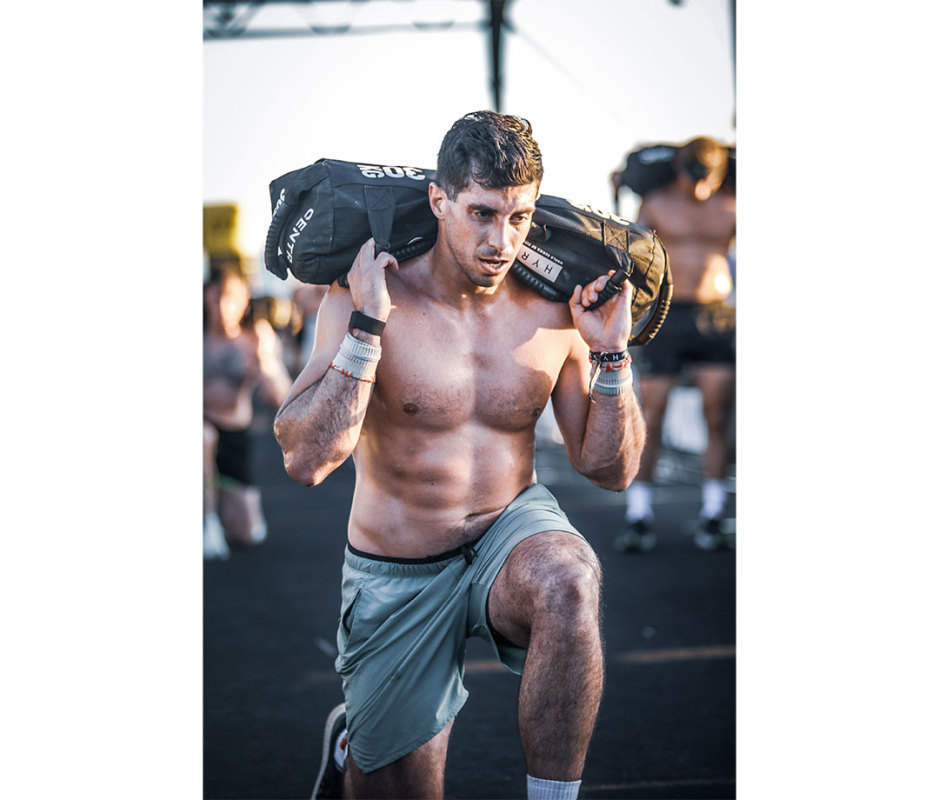
Courtesy Image
Unlike CrossFit, Hyrox approaches the competition landscape from a running angle. Running has a low barrier to entry, most of us have done it recreationally (or competitively), and it keeps the event inclusive, Toetzke says. By sandwiching each functional movement with a 1K run, it acts as a physical reset (as much as running can be considered a "reset"), but also introduces a unique competition environment. It's not the strongest lifters coming out on top; in a way, this levels the playing field and gives endurance athletes an edge. Moreover, the exercises that comprise the Hyrox workout are specifically chosen to be more intuitive to participants.
"Everyone can push a sled," Toetzke elaborates. "You might not be fast, but you can’t really do something technically wrong.” This is in contrast to CrossFit's intricate, skill-based Olympic lifts like the snatch, which can make workouts feel daunting and less accessible.
Related: These Calf Exercises Are Guaranteed to Bulk Up Skinny Legs
Hyrox Workout
All of these considerations led to the birth of Hyrox, a one-of-a-kind fitness spectacle featuring eight rounds of a 1K run followed by a unique workout station. Here's the Hyrox workout at a glance; also be sure to check out our comprehensive guide to the Hyrox workout for how-tos and expert tips.
- Station 1: SkiErg
- Station 2: Sled push
- Station 3: Sled pull
- Station 4: Burpee broad jumps
- Station 5: Rowing
- Station 6: Farmer’s carry
- Station 7: Sandbag lunges
- Station 8: Wall balls
One of the coolest things about the Hyrox workout is its consistency. The distance and order of movements are always the same, allowing you to compare your performance from race to race. Once you’ve done one event, you’ll know exactly what to expect in future races, which is a huge confidence booster. Plus, for elite athletes, this consistency allows you to see how you stack up on the global leaderboard.
Waves of athletes enter the competition floor every 10 minutes throughout the day, covering all divisions: open, pro, doubles, mixed doubles, weighted vest, and relay. Each participant has the opportunity to tailor their experience, making it as intense or as enjoyable as they desire.
Hyrox Divisions
- Open: best for beginners
- Pro: best for experienced racers
- Weighted Vest: best for advanced racers looking for a challenge
- Doubles: best for beginner and intermediate racers who want to split the workload with a same-sex partner
- Mixed Doubles: best for beginner and intermediate racers who want to split the workload with a mixed-sex partner
- Relay: groups who want to tag-team the event
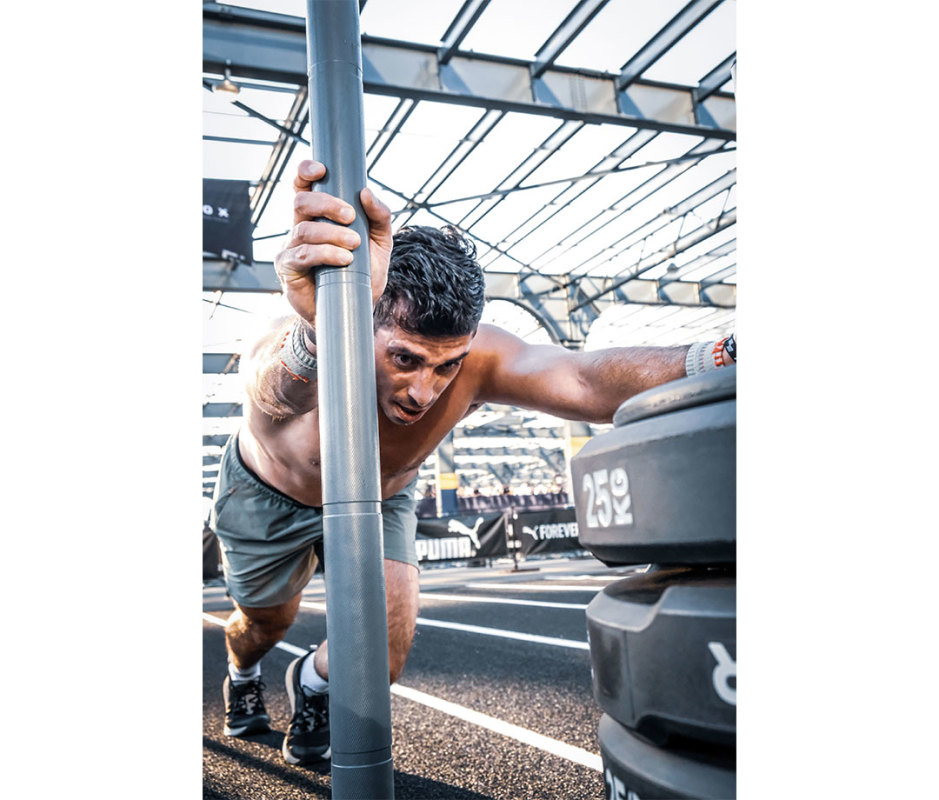
Courtesy Image
What to Expect of Hyrox, From Registration to Race Day
Registration
Hyrox knows how to keep its athletes in the loop and hyped for race day. From the moment I signed up, I received regular emails. These went beyond basic logistics like hotel and transportation. They included everything from a Hyrox athlete guide (think rulebook) to a detailed venue map, motivational words of encouragement to discounts from supplement partners. By the time race day rolled around, I knew exactly when my heat would start, how the schedule would play out, and all the check-in details, leaving me fully prepared and ready to go.
Check-In
As I approached the venue, I heard the event before I saw it. Upon entering the gates, I was ushered to the check-in area to pick up my chip timer. Like a marathon or triathlon, the bracelet straps to your ankle to track split times. Hyrox advises participants show up at least 90 minutes before their start time. This gives you plenty of time to check in, warm up, and mentally prepare.
If you’re a first-timer like I was, I highly recommend getting there early to understand the event flow. Watching a few heats helped ease my nerves, and I quickly realized how intuitive the setup was. All the stations are clearly labeled, and a massive screen tracks your progress throughout the race. Since most venues don’t have a full 1,000-meter course, you’re likely to run two laps around the venue before heading into the Rox Zone, which is the transition area between your run and the next station.
Related: The Best Cross-Training Shoes of 2024 to Support Every Workout
Atmosphere
As I navigated through throngs of cheering spectators, I stopped at the wall balls, the final station. This area, known as the “Thunder Dome,” was flanked by grandstands on either side, sardined with family members and friends waiting to see their athlete cross the finish line. At the center of it all was a Red Bull DJ truck that pulsed with a thundering bass. The DJ wasn’t just playing music, he was narrating the action, hyping up the crowd, and keeping energy levels sky-high from the first heat to the last, even announcing when notable figures like Lance Armstrong neared the finish. He counted down many athletes' final reps, urging them to empty the tank.
Vendors and Aid Stations
After tearing myself away from the wall ball station, I ventured into the vendor area. Here, companies like Gainful and PwrLift offered free samples to keep both athletes and spectators hydrated and fueled. Recovery stations equipped with zero gravity chairs and ice bath plunges provided athletes a chance to cool down and rejuvenate as temps soared. NYC was the first outdoor Hyrox event and the sun baked the semi-exposed pier.
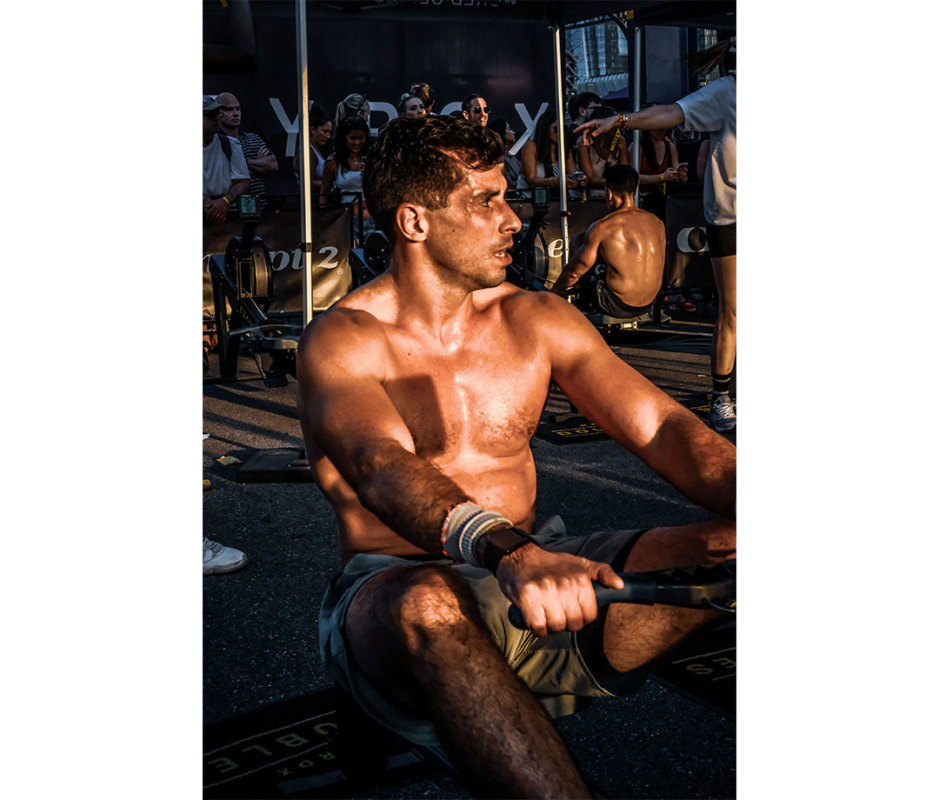
Courtesy Image
Hyrox Race: My Firsthand Experience
When the clock hit 6p.m., it was finally time to get moving. I headed to the athlete warmup area to clock a few minutes on the Concept 2 rower to get my heart rate up, followed by sled push and pulls to get a feel for the weight. The men’s Pro Division sled push was no joke at 202 kilograms (about 445 pounds). Fortunately, I managed to get it moving, assuring myself that once I hit the competition floor, the crowd’s energy would keep me going. I wrapped up my warmup with a few sandbag lunges and burpee broad jumps. With 15 minutes to spare, I hydrated, tucked an energy gel into my pocket (planning to consume it on the rower), and mentally prepared for what lay ahead.
Five minutes before my heat, I checked in at the start line, an inflatable tunnel where athletes gather before the race. Inside, a Hyrox team member was firing everyone up, encouraging sportsmanship, and reminding us all to enjoy the experience. As the clock counted down from 60 seconds, the tunnel grew quiet, and I could hear people taking deep breaths and readying themselves for the race. At 10 seconds, a few athletes started pushing toward the front. I hung back, letting the superstars lead the charge—after all, the race doesn’t officially start for you until your chip timer crosses the line.
3, 2, 1, go!
The crowd cheered as the first heat of the men’s Pro Division took off, and I began my first 1,000-meter run. I tempered the urge to push the pace, merging with runners from other heats. This felt a bit chaotic, but Hryox has everything down to a science. You'll always have a spot when you enter a new station.
Station 1
After two laps around the venue, I entered the 1,000m ski. This was familiar territory for me—something I regularly do at my CrossFit gym—so I pushed hard and caught up with the lead pack. One thing I noticed as soon as the race started was that all of the top Hyrox athletes are phenomenal runners. They push the pace on runs, which makes up the majority of the race, while I had to rely on my strength in the stations. My strategy worked well enough for my goals and ability level, but if you want to be a serious contender, you'll need to prioritize running in your training—and lots of it.
With the SkiErg done, I got the nod from my judge, and navigated through the “Rox Zone Out” arch, careful to exit through the correct inflatable to avoid penalties. Your chip timer tracks everything, so staying on course is crucial, but I promise the course layout is intuitive and easy to navigate.
Station 2
Next up was the sled push—445 pounds over four laps. I felt confident and powered through, later discovering it was my best station, ranking 14th out of 100+ men in the Pro Division. This is just an example of the precise stats Hyrox sends you after the event, allowing you to see your exact splits at each station, the amount of time you spent in the Rox Zone, and the time it took each run.
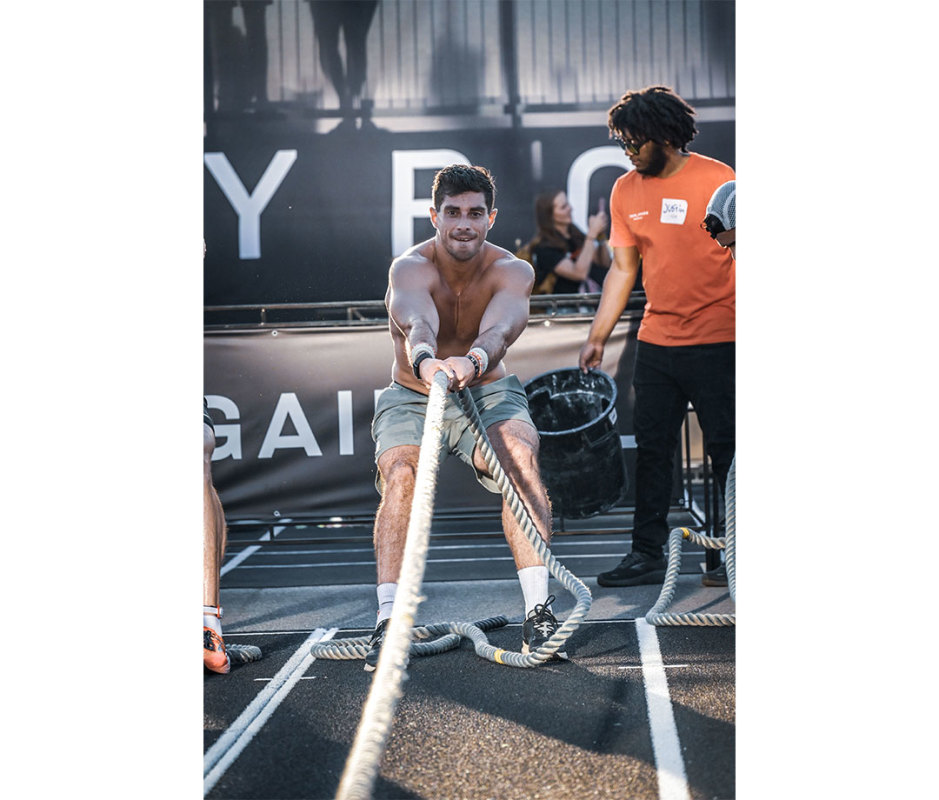
Courtesy Image
Station 3
I headed out for another run, still feeling good, and arrived at the sled pull. There’s a box your feet must stay inside of or you may be hit with a penalty. The box does have some room to it, which allows you to grab the rope and walk the sled back a few steps. I recommend this strategy so you’re not just pulling hand over hand, exclusively using your arms.
Station 4
The next run led to 80m burpee broad jumps, which I found to be the hardest station on the course. This movement just crushes your legs, however, once done, you’re officially halfway through the race.
Station 5
Station five is the 1,000m row and the only time you’ll have a chance to sit during the Hyrox race. This is when I’d recommend consuming any intra-workout nutrition you plan on using like an energy gel or sports drink. Note that Hyrox does have a hydration station in the Rox Zone with Gatorade and water, and you can always grab a drink as you run by.
Station 6
Station six is the 200-meter kettlebell farmer's carry, which is quick but requires some grip strength. Do your best to hang on to the kettlebell as long as you can—ideally not stopping or setting them down. Keep your feet moving quickly.
Station 7
Legs leaden, lungs burning, I entered station seven, the 100-meter sandbag lunges. I heard the announcer mention we were an hour into the race. Every lunge felt brutal, but at this point you can finally see the light at the end of the tunnel. You're not permitted to drop the sandbag during this event, even when you're in the Doubles division.
Station 8
The final run was a relief—I was almost done. After two laps, I entered station eight: 100 wall balls. I chipped away in sets of 10, making the final station feel endless, but I finally crossed the finish line. My smile beamed with pride just as my muscles swelled with lactic acid.
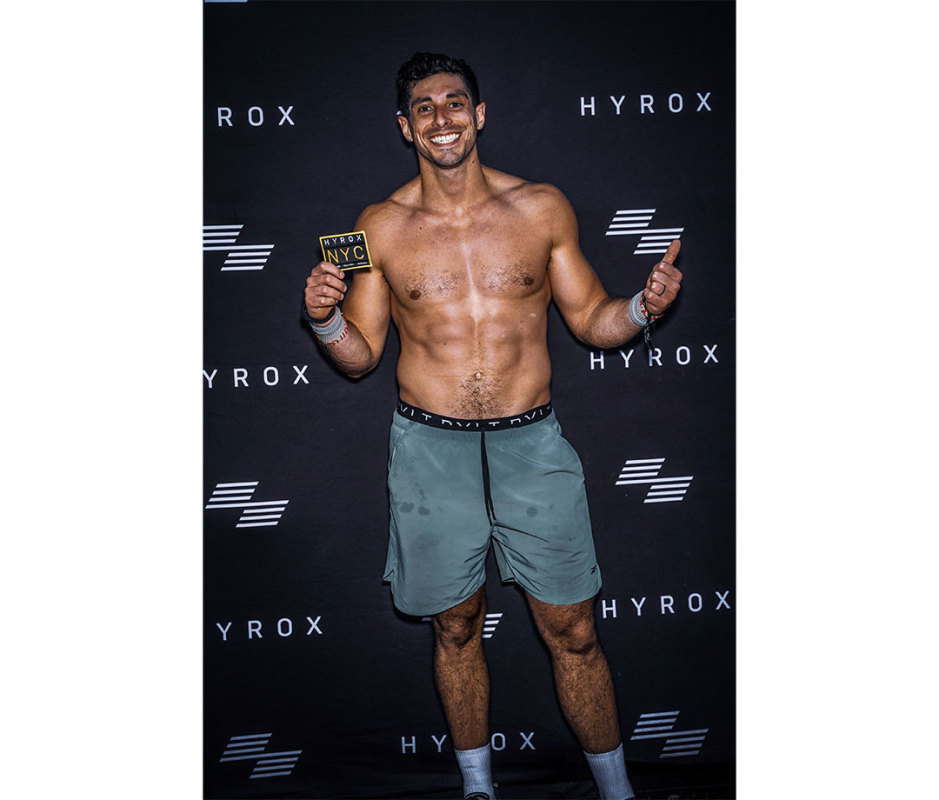
Courtesy Image
The Takeaway
If you asked me what the best part of a Hyrox race is, hands down it’s the camaraderie. From start to finish, fellow competitors exchanged high-fives, cheered each other on, and kept the energy high. The crowd, judges, DJ, and even random strangers were all incredibly supportive, making it one of the best fitness events I've been a part of. If you're on the fence about trying Hyrox, I can't recommend it enough.
FAQs
How Long Does a Hyrox Race Take?
A Hyrox race typically takes 1 hour and 40 minutes to complete. While elite athletes can power through in less than an hour, others may take a bit longer, depending on their pace and overall fitness level. This timing is designed to push participants to their limits, offering a challenging yet rewarding experience that feels like a true accomplishment no matter where you finish.
How Long Should I Train for a Hyrox Race?
Training for a Hyrox race typically requires a solid six to eight weeks of preparation, depending on your current fitness level and experience with endurance events. This amount of time should be enough for you to build the endurance, strength, and technique needed to tackle the race’s unique combination of running and workout stations. Ideally, your training should consist of a mix of running, strength training, and specific Hyrox workouts to ensure you’re well-prepared for rest day.
Related: How to Improve VO2 Max: The Only 2 Workouts You Need
What Equipment Do I Need for Hyrox Training?
To effectively train for a Hyrox race, you'll need a blend of standard workout gear and some specialized equipment. A quality pair of running shoes tops the list, as running makes up a significant portion of the race. Beyond that, you'll want to incorporate kettlebells (dumbbells will work fine for training), a wall ball, and cardio machines like a rower and SkiErg. Lastly, adding a sandbag, sled, and a rope for sled pulls will help you replicate the race's unique challenges. This combination of gear will ensure you're well-prepared to tackle every aspect of the Hyrox course. There are dedicated Hyrox partner gyms, but most boutique and big-box studios will have this equipment, too.
If you're building out your home gym, note Hyrox partnered with Centr, a fitness, nutrition, and mental wellness personal training app created in collaboration with Chris Hemsworth. Centr now supplies the competition-grade equipment, outside of the SkiErg and RowErg developed by Concept 2, for all Hyrox events, including wall balls, wall ball targets, sandbags, power ropes, power sleds, kettlebells, and bumper plates.
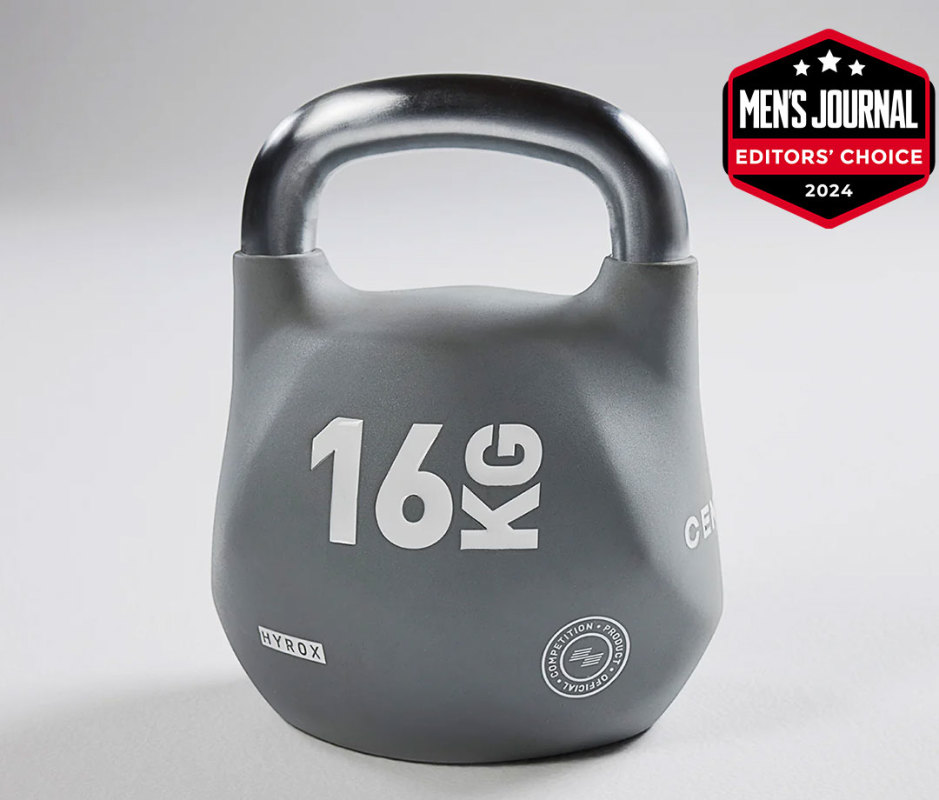
Courtesy Image
Hyrox Anaheim Learnings
During the NYC event, I spoke with Andrew Sugerman, CEO of Centr, to chat about the new equipment. Sugerman’s initial experience with Hyrox was at the 2023 event held in Anaheim, CA, where he walked the floor to learn what was working and what wasn’t. Centr, in conjunction with HYROX, spent months to ideate and prototype new equipment to elevate performance.
“For these designs, we worked with some of Hyrox’s elite athletes like David [Magida, 2023 North American Champion] to ensure they'd work for the event,” Sugerman notes.
The prototyping paid off. For instance, the Centr Competition Power Sled features handles on both sides that come with a knurled texture, designed to keep your grip firm as you power through multiple rounds of sweaty sled pushes.
In addition, the Centr Competition Octo Kettlebell, designed for the farmer's carry station, features a flattened octagonal shape to minimize bumping against thighs. These innovative designs reflect the commitment of both Hyrox and Centr to delivering an exceptional and enjoyable race day for all participants.
Sugerman also hinted at some exciting behind-the-scenes developments for Centr’s fitness app in relation to Hyrox training.
He says to be on the lookout if you want to “analytically see where you’re at, and what you should prioritize in training” to excel in the sport.
from Men's Journal https://ift.tt/idFPxzN
No comments:
Post a Comment